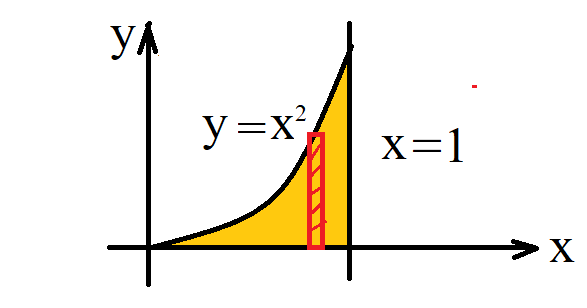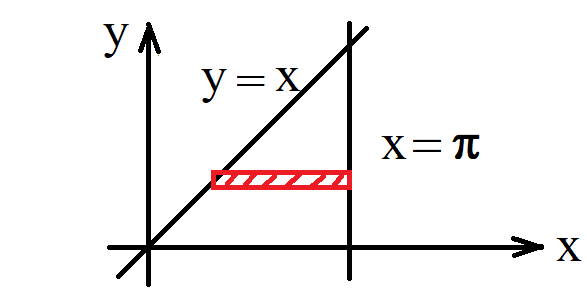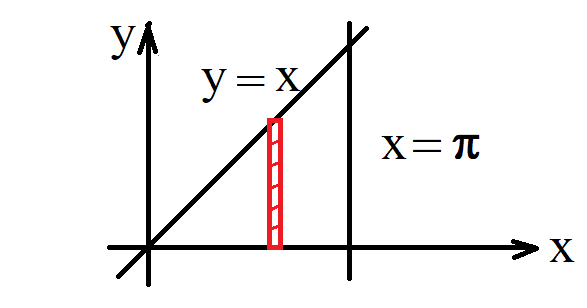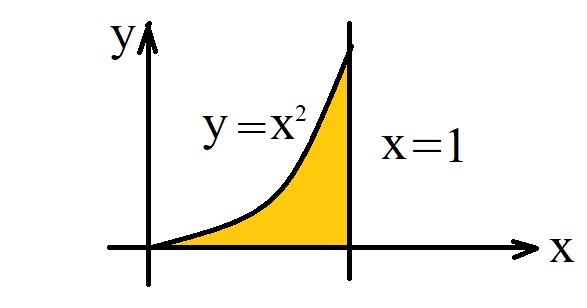- The area as a double integral:
$A = \intd{A} dxdy, \m dA = dxdy$
;
| $A = \intd{A} dxdy$
$=\int_{x=0}^{1}\Big(\int_{y=0}^{x^2} 1 dy\Big)dx $
$= \int_{x=0}^{1} y\Big|_{y=0}^{y=x^2} dx$
$= \int_{x=0}^{1} x^2 dx$
$ = \frac13 x^3\Big|_{x=0}^1 = \frac13$ |

|
- Mass: If the density $\rho(x,y) $ or $\rho(x,y,z)$ is given, then the mass is given by
2D:
$M = \intd{A} \rho(x,y) dxdy , \m dM =\rho(x,y) dxdy$
;
Suppose in the above example for area under $y=x^2$ between $x=0$ and $x=1$,
$\rho(x,y) = xy$, then
$M = \intd{A} xy dxdy$
$=\int_{x=0}^{1}\Big(\int_{y=0}^{x^2} xy dy\Big)dx $
$= \int_{x=0}^{1} \frac12 xy^2\Big|_{y=0}^{y=x^2} dx$
$= \int_{x=0}^{1} \frac12 x^5 dx$
$ = \frac1{12} x^6\Big|_{x=0}^1 = \frac1{12}$
3D: $M = \int\hspace{-0.7em}\intd{V} \rho(x,y,z) dxdydz , \m dM =\rho(x,y,z) dxdydz$
;
- Arc Length:
If $y = f(x)$, then
$ ds = \sqrt{ dx^2 + dy^2 } = \sqrt{1+ \Big(\frac{dy}{dx}\Big)^2} dx $
;
Suppose in the above example, we like to compute the arc length of $y=x^2$ between $x=0$ and $x=1$, then
$S =\int_{x=0}^{1} \sqrt{1+ \Big(\frac{df}{dx}\Big)^2 } dx $
$= \int_{x=0}^{1} \sqrt{1+(2x)^2} dx$
$= 4\int_{x=0}^{1} \sqrt{\Big(\frac12\Big)^2 + x^2} dx$
$ = \frac14\Big\{2\sqrt5 +\ln(2+\sqrt5)\Big\}$
$ \fcolorbox{white}{yellow}{$\int \sqrt{a^2+u^2} du = \frac{u}2 \sqrt{a^2+u^2} + \frac{a^2}2 \ln( u+\sqrt{a^2+u^2})$} $
- Center of mass $(\bar x, \bar y, \bar z)$: Writing $\int$ for either $\intd{}$ or $\intd{}\hspace{-0.7em}\int$,
$ \int \bar x dM = \int x dM, \m \int \bar y dM = \int y dM, \m \int \bar z dM = \int z dM, \m dM = \rho(x,y,z)dxdydz $
;
Suppose in the above example, $\rho(x,y)=1$, then
$\intd A \bar x dM = \intd A x dM$, $dM = \rho(x,y) dxdy = dxdy$,
$\intd A \bar x dM = \bar x \int_{x=0}^{1}\Big(\int_{y=0}^{x^2} dy\Big)dx = \bar x \frac13$
$\intd A x dM = \int_{x=0}^{1}\Big(\int_{y=0}^{x^2} x dy\Big)dx = \int_{x=0}^{1} x^3 dx = \frac1{4}$
$ \bar x \frac13 = \frac14, \mm \bar x = \frac34$.
Similarly
$ \bar y = \frac3{10}$.



